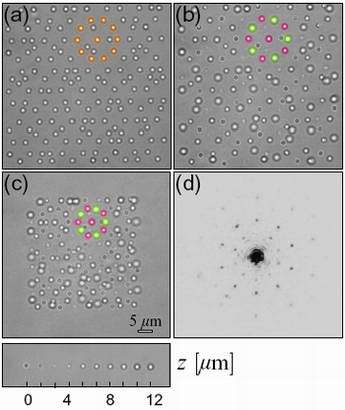Physicists find way to create 3D quasicrystals

New York University physicists have applied a ground-breaking nanotechnology method to create three-dimensional quasicrystals, highly ordered structures that, unlike conventional crystals, never repeat themselves.
Image: Holographic assembly of a three-dimensional colloidal quasicrystal. (a) Colloidal particles trapped in a two-dimensional projection of a three-dimensional icosahedral quasicrystalline lattice. (b) Particles displaced into the fully three-dimensional configuration. The shaded region identifies one embedded icosahedron. (c) Reducing the lattice constant creates a compact three-dimensional quasicrystal. (d) Optical diffraction pattern showing ten-fold symmetric peaks. The three-dimensional assembly process is shown in the associated movie.
Metallic quasicrystals created from exotic alloys have shown promise for storing hydrogen more efficiently than crystalline hosts. Their non-repeating structure has the potential to dramatically strengthen industrial and commercial products. The NYU quasicrystals, by contrast, are made of glass and plastic and have potentially revolutionary optical properties.
The research, authored by NYU physicists David Grier and Yael Roichman, appears in the July 11 issue of Optics Express, a journal of the Optical Society of America.
Quasicrystals, discovered in the mid-1980s, are different from crystals, whose periodic structures resemble the patterns of tiles on a bathroom floor. By contrast, quasicrystals do not have this property, called translational symmetry, but, like crystals, can be rotated into registry with themselves, a property called rotational symmetry.
Quasicrystals’ rotational symmetry gives them many of the properties of conventional crystals. These same symmetries are responsible for conventional semiconducting crystals’ ability to act as switches for electrons. However, because quasicrystals do not possess the translational symmetry of conventional crystals, they have the freedom to take a broader range of forms, opening up the potential to serve a range of functions.
The quasicrystals reported by Roichman and Grier are created from tiny glass spheres, each comparable in size to the wavelength of light, stacked precisely in mathematically defined configurations. Like the crystalline structures responsible for the irridescence of gem opals and the colors of butterfly wings, these quasicrystalline sphere packings diffract different wavelengths of light into different directions, creating a rainbow-like display. For particular structures, and particular wavelengths, however, the quasicrystals offer no path at all for light. The resulting gaps in the rainbow, known as photonic bandgaps, can be manipulated to create switches for light. For instance, when translated into structures with features comparable to the wavelength of light, these properties of quasicrystals should enable them to manipulate light in much the same way that semiconductors manipulate electrons.
This has already been achieved for two-dimensional structures by previous researchers. However, prior to the work of Roichman and Grier, scientists had not been able to branch out into three-dimensional quasicrystals—thereby reaping the full benefits of their unique properties—because of the inability to create this class of quasicrystals with the proper materials at the right size scale.
Previous attempts at addressing this challenge included the use of lithographic techniques. In a departure from this approach, Roichman, Grier, and their colleagues used a method developed by Grier’s group called holographic optical trapping. This allows scientists to manipulate objects as small as a few nanometers across and as large as several hundred micrometers. These “optical tweezers” allow scientists to organize microscopic objects into interesting and useful configurations, to dissect them, to assemble them into devices, or to chemically transform them, all with unprecedented precision. Using this method on quasicrystals, Roichman and Grier were able to organize hundreds of free-floating microspheres into densely packed structures defined by the mathematical definition of quasicrystalline order.
Grier is part of an NYU team of internationally recognized physicists in the field of soft condensed matter physics, a new inter-disciplinary field that explores how materials are organized at microscopic levels, and which studies the physical properties of malleable materials such as colloids and polymers. With Grier, Paul Chaikin, formerly of Princeton University, and David Pine, formerly of the University of California, Santa Barbara, form the core of NYU’s Center for Soft Matter Research. Yael Roichman is a postdoctoral researcher in Grier’s group.
Source: New York University















